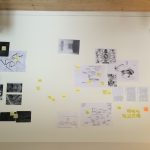I came into the residency with an embryonic project which drew loose connections between mushrooms, blockchain, and haptic sensory networks. I suppose the project attempts to ask some basic and rather abstract questions that it will inevitably fail to answer, such as: what is the world like, and what is the nature of our agency within it?; how do systems emerge, and how do they change and disappear?; how do materials communicate? Once you start wondering about some of these things in concrete terms (the networked technologies and ecologies amongst which we live), there’s something compelling about the utter mess of it, a mad tangle of tentacles, fronds and submarine optical fibres, inextricably bound together like rats in a rat king. That is what the world is like.
Having gotten myself into this mess, the first thing I needed to do was to lay the project out and cut off some tentacles. I made a map of sorts on the wall in the studio, which helped a little. It’s a bad sign when you can’t keep up with all the elements of a project at once, but given the subject it also seemed appropriate, somehow.
The prebiotic earth
The residency started off at a nice pace. The weather was awful but I got to see the Kittiwakes hatch. Early on, I had a meeting at Quillam Brothers with a researcher named Ben Shirt-Ediss, which ended up having quite a massive influence on the narratives that I was beginning to construct. Ben is a computer scientist who researches the Origins of Life, a field that straddles biology and chemistry (something that doesn’t happen often, apparently).
“The prebiotic earth” was a phrase that stuck with me; how often do we imagine a world in which there are not only no plants, but no bacteria, no cells at all? Basically, we don’t know an awful lot about how life formed. The first known fossils go back 3.5bn years (!), and at some time before that, the noxious swill of terrestrial chemistry somehow produced the conditions for immensely complex little self-replicating systems with metabolisms to form. Ben’s research takes an autonomous approach to protocells, a primitive ghost of a cell which, while not itself alive, is the precursor and prerequisite to cellular life. (The life/not life debate is itself blurry and fascinating: there is no clear line.) Grossly simplified, Ben’s dissertation argues for an autonomous approach to the formation of far-from-equilibrium systems: global conditions in the prebiotic soup that allowed for little fatty bubbles (vesicles) to form, holding certain chemical reactions captive that then lead to the formation of a rudimentary metabolism. Something resembling cellular life begins to form, a system that maintains its own order and complexity while everything dissipates around it.
I began to write a little about protocells as they seemed to be a literal ur-image of what I’ve been exploring: the ways in which material organisation produces techniques and diagrams of communication and control. That is, the ways in which the embodiment of a system within an environment — its morphology, its composition, the physical forces acting upon it — determine its behaviour, and how simple interactions with a dynamic environment of other systems can result in extraordinary complexity. Slime moulds, for instance, comprise decentralised networks of sensitive tendrils which allow them to make intelligent decisions as a complex, swarm-like whole. Fungal mycelia undergird entire forests until it’s hard to say if they belong to a single mushroom or a million, communing with trees and with one another for mutual mineral benefits. In the case of protocells, deep in the geothermal swells of a barely solidified earth, froths and foams jostle about in the dead juices to dream collective dreams about the viability of life.



